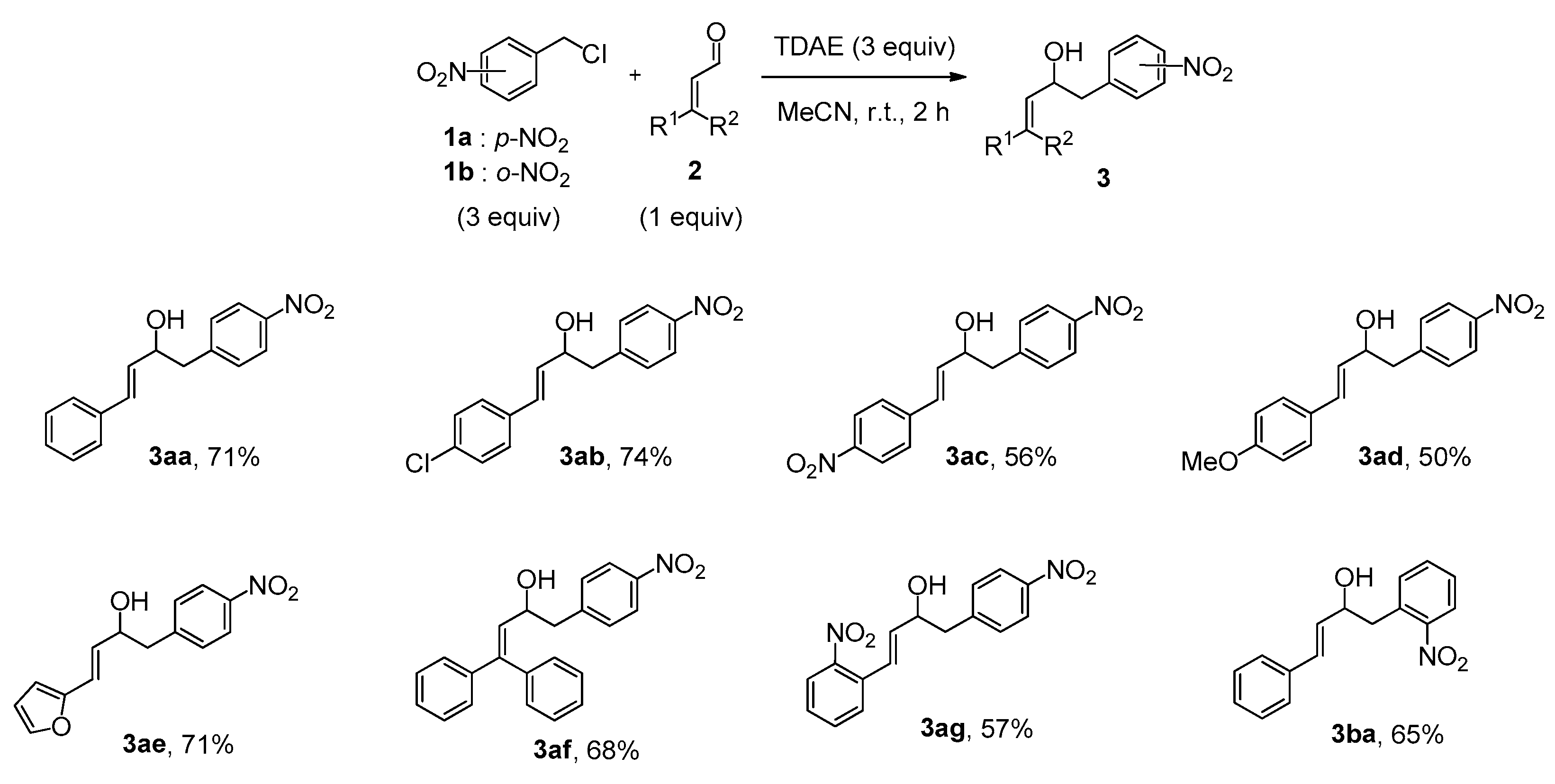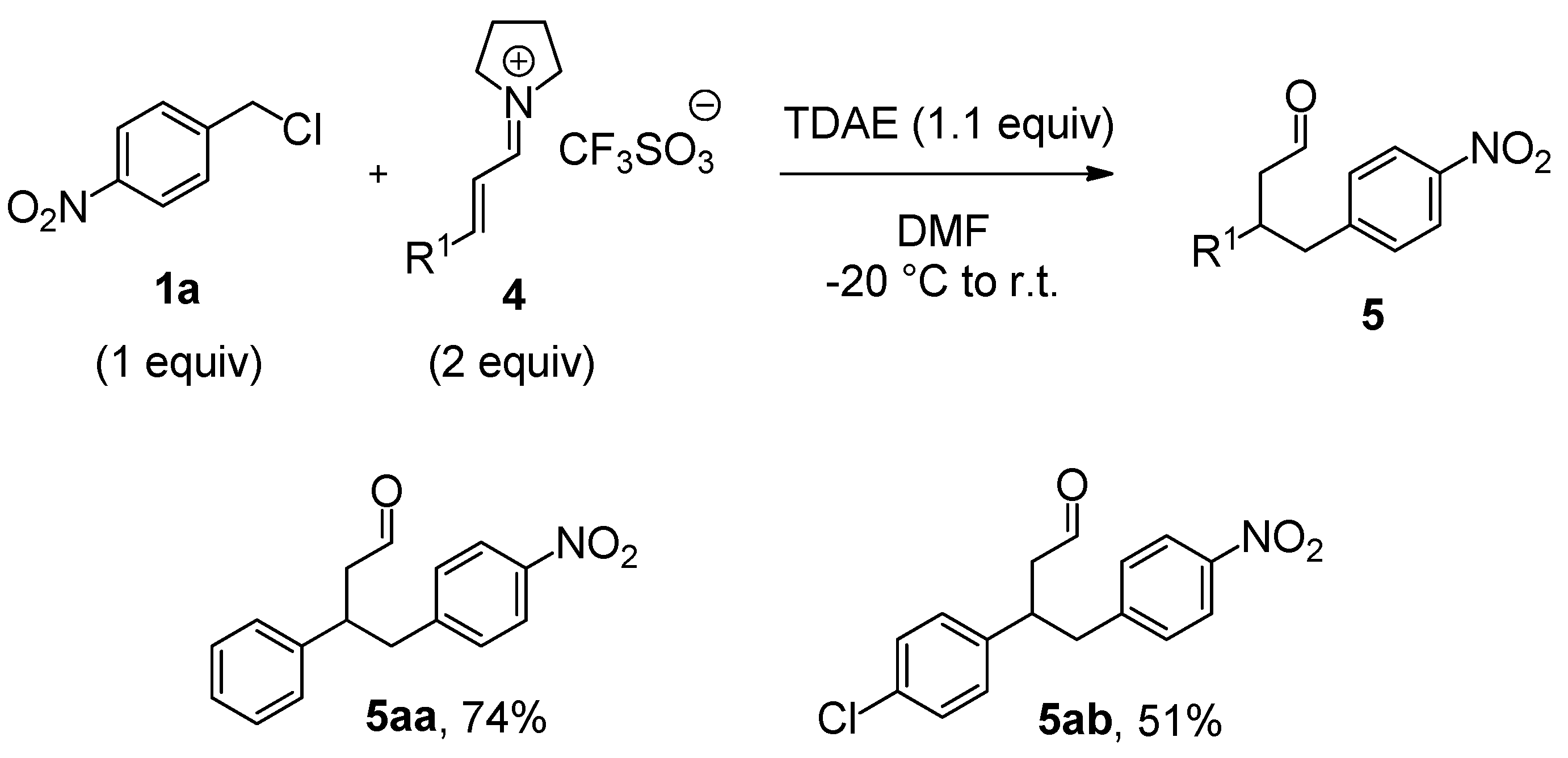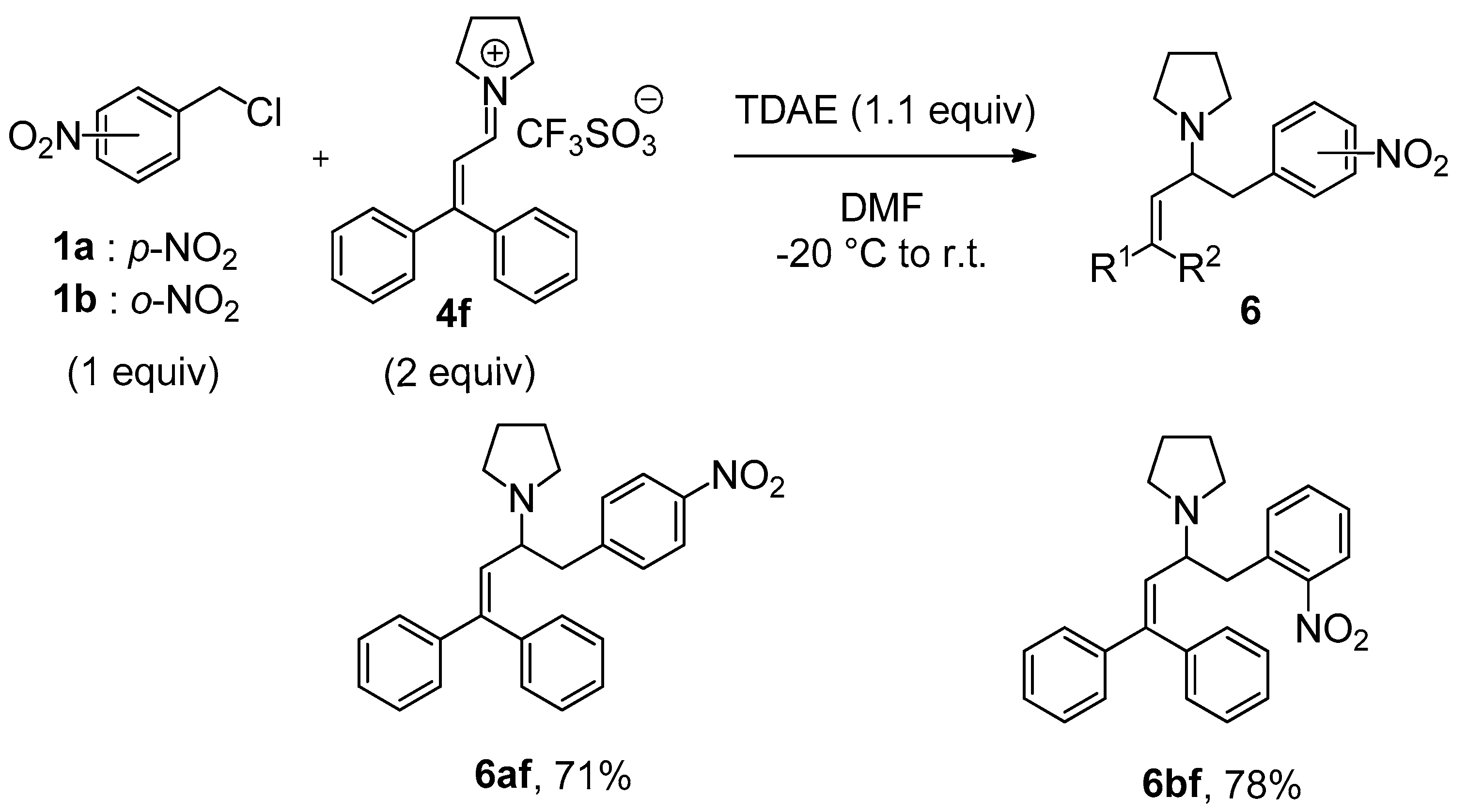Metal-Free Regiodivergent Addition of Carbon Nucleophiles to α,β-Unsaturated Electrophiles
Abstract
:1. Introduction
2. Results and Discussion
3. Experimental Section
3.1. General
3.2. General Procedure for the Synthesis of Alcohols 3
3.3. General Procedure for the Synthesis of Iminium Salts 4
3.4. General Procedure for the Synthesis of Aldehydes 5 and Allylic Amines 6
4. Conclusions
Supplementary Materials
Acknowledgments
Author Contributions
Conflicts of Interest
References
- Perlmutter, P. Conjugate Addition Reactions in Organic Synthesis; Pergamon Press: Oxford, UK, 1992. [Google Scholar]
- Krause, N.; Hoffman-Roder, A. Recent advances in catalytic enantioselective Michael additions. Synthesis 2001, 2, 171–196. [Google Scholar] [CrossRef]
- Sibi, M.; Manyem, S. Enantioselective conjugate addition. Tetrahedron 2000, 56, 8033–8061. [Google Scholar] [CrossRef]
- Kanai, M.; Shibasaki, M. Catalytic Asymmetric Synthesis, 2nd ed.; Ojima, I., Ed.; Wiley: New York, NY, USA, 2000; p. 569. [Google Scholar]
- Tomioka, K.; Nagaoka, Y. Comprehensive Asymmetric Catalysis; Jacobsen, E.N., Pfaltz, A., Yamamoto, H., Eds.; Springer: Berlin, Germany, 1999; Volume 3, Chapter 31.1. [Google Scholar]
- Tsogoeva, S.B. Recent advances in asymmetric organocatalytic 1,4-conjugate additions. Eur. J. Org. Chem. 2007, 11, 1701–1716. [Google Scholar] [CrossRef]
- Takechi, N.; Aït-Mohand, S.; Médebielle, M.; Dolbier, W.R., Jr. Nucleophilic trifluoromethylation of acyl chlorides using the trimethyl iodide/TDAE reagent. Tetrahedron Lett. 2002, 43, 4317–4319. [Google Scholar] [CrossRef]
- Pooput, C.; Médebielle, M.; Dolbier, W.R., Jr. A new and efficient method for the synthesis of trifluoromethylthio- and selenoethers. Org. Lett. 2004, 6, 301–303. [Google Scholar] [CrossRef] [PubMed]
- Pooput, C.; Médebielle, M.; Dolbier, W.R., Jr. Nucleophilic perfluoroalkylation of aldehydes, ketones, imines, disulfides, and diselenides. J. Org. Chem. 2006, 71, 3564–3568. [Google Scholar] [CrossRef] [PubMed]
- Giuglio-Tonolo, G.; Terme, T.; Médebielle, M.; Vanelle, P. Original reaction of p-nitrobenzyl chloride with aldehydes using tetrakis(dimethylamino)ethylene (TDAE). Tetrahedron Lett. 2003, 44, 6433–6435. [Google Scholar] [CrossRef]
- Giuglio-Tonolo, G.; Terme, T.; Médebielle, M.; Vanelle, P. Nitrobenzylation of α-carbonyl ester derivatives using TDAE approach. Tetrahedron Lett. 2004, 45, 5121–5124. [Google Scholar] [CrossRef]
- Amiri-Attou, O.; Terme, T.; Vanelle, P. Functionalization of 6-nitrobenzo[1,3]dioxole with carbonyl compounds via TDAE methodology. Molecules 2005, 10, 545–551. [Google Scholar] [CrossRef] [PubMed]
- Montana, M.; Terme, T.; Vanelle, P. Original synthesis of α-chloroketones in azaheterocyclic series using TDAE approach. Tetrahedron Lett. 2006, 47, 6573–6576. [Google Scholar] [CrossRef]
- Khoumeri, O.; Terme, T.; Vanelle, P. Original and efficient synthesis of substituted 3,4-dihydronaphtho[2,3-g]quinoline-2,6,11(1H)-triones. Synthesis 2009, 3677–3683. [Google Scholar] [CrossRef]
- Khoumeri, O.; Giuglio-Tonolo, G.; Crozet, M.D.; Terme, T.M.; Vanelle, P. Original synthesis of 2-substituted-4,11-dimethoxy-1-(phenylsulfonyl)-2,3-dihydro-1H-naphtho[2,3-f]indole-5,10-diones using TDAE and Cu-catalyzed reaction strategy. Tetrahedron 2011, 67, 6173–6180. [Google Scholar] [CrossRef]
- Spitz, C.; Khoumeri, O.; Terme, T.; Vanelle, P. Diastereoselective synthesis of N-tert-butanesulfinylamines through addition of p-nitrobenzyl chloride to N-tert-butanesulfinimines using a TDAE strategy. Synlett 2013, 24, 1725–1727. [Google Scholar] [CrossRef]
- Spitz, C.; Lin, A.; Terme, T.; Vanelle, P. Mild and Metal-Free Diastereoselective Synthesis of N-tert-Butanesulfinylamines by Using Tetrakis(dimethylamino)ethylene. Synthesis 2014, 46, 3229–3232. [Google Scholar] [CrossRef]
- Spitz, C.; Mathias, F.; Giuglio-Tonolo, A.-G.; Terme, T.; Vanelle, P. Practical and metal-free synthesis of novel enantiopure amides containing the potentially bioactive 5-nitroimidazole moiety. Molecules 2016, 21, 1472. [Google Scholar] [CrossRef] [PubMed]
- Spitz, C.; Terme, T.; Vanelle, P. Mild and metal-free regioselective 1,2-addition of carbon nucleophiles to α,β-unsaturated imines. Synlett 2016, 27, 301–303. [Google Scholar] [CrossRef]
- Erkkilä, A.; Majander, I.; Pihko, P.M. Iminium catalysis. Chem. Rev. 2007, 107, 5416–5470. [Google Scholar] [CrossRef] [PubMed]
- Lakhdar, S.; Tokuyasu, T.; Mayr, H. Electrophilic reactivities of α,β-unsaturated iminium ions. Angew. Chem. Int. Ed. 2008, 47, 8723–8726. [Google Scholar] [CrossRef] [PubMed]
Sample Availability: Samples of the compounds 3aa–3ag, 3ba, 4b, 4f, 5aa, 5ab, 6af and 6bf are available from the authors. |





| Entry | 1a (Equiv) | 2a (Equiv) | TDAE (Equiv) | Solvent | Yield of 3aa (%) b |
|---|---|---|---|---|---|
| 1 | 1 | 1.2 | 1 | MeCN | 33 |
| 2 | 1 | 2 | 1 | MeCN | 48 |
| 3 | 1 | 2 | 1 | DMF | 42 |
| 4 | 1 | 2 | 1 | MeCN | 37 c |
| 5 | 2 | 1 | 2 | MeCN | 53 |
| 6 | 2 | 1 | 2 | MeCN | 55 d |
| 7 | 3 | 1 | 3 | MeCN | 62 d |
| 8 | 3 | 1 | 3 | MeCN | 67 d,e |
| 9 | 3 | 1 | 3 | MeCN | 71 d,f |
© 2017 by the authors. Licensee MDPI, Basel, Switzerland. This article is an open access article distributed under the terms and conditions of the Creative Commons Attribution (CC BY) license (http://creativecommons.org/licenses/by/4.0/).
Share and Cite
Spitz, C.; Giuglio-Tonolo, A.G.; Terme, T.; Vanelle, P. Metal-Free Regiodivergent Addition of Carbon Nucleophiles to α,β-Unsaturated Electrophiles. Molecules 2017, 22, 1178. https://doi.org/10.3390/molecules22071178
Spitz C, Giuglio-Tonolo AG, Terme T, Vanelle P. Metal-Free Regiodivergent Addition of Carbon Nucleophiles to α,β-Unsaturated Electrophiles. Molecules. 2017; 22(7):1178. https://doi.org/10.3390/molecules22071178
Chicago/Turabian StyleSpitz, Cédric, Alain G. Giuglio-Tonolo, Thierry Terme, and Patrice Vanelle. 2017. "Metal-Free Regiodivergent Addition of Carbon Nucleophiles to α,β-Unsaturated Electrophiles" Molecules 22, no. 7: 1178. https://doi.org/10.3390/molecules22071178




